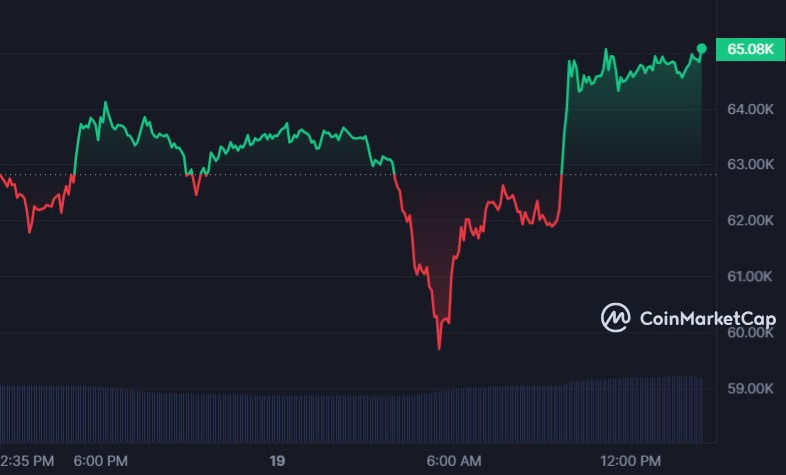Key Points
- Bitcoin’s halving event is scheduled to take place a few hours from now.
- Significant firms in the crypto industry address the miners’ future post-halving.
Bitcoin’s halving event is scheduled to take place around 15 hours for now, and it will cut Bitcoin miner rewards per block from 6.25 BTC to 3.125 BTC.
The important event comes after a very tumultuous scenery filled with multiple geo-political events that triggered huge market volatility with sudden price drops and unexpected rebounds for Bitcoin.
At the moment of writing this article, just a few hours ahead of the halving, Bitcoin is trading above $65k, up by almost 4% in the past 24 hours on CoinMarketCap.

CleanSpark Chief Communications Officer Isaac Holyoak addressed the future of Bitcoin miners post-halving. He said that this event will most likely be similar to the season that it accompanies – “in like a lion and out like a lamb. Then, the wolves.”
He explained that what he means is the fact that there is a lot of excitement around the event, but in terms of practical impact, we will only see it in a few months. He stated that the market will witness a war of attrition as less efficient miners are holding on for as long as they can, but then comes the M&A.
2024 halving will be different
Brian Wright, Galaxy’s co-head of Mining, explained the fact that while the past Bitcoin halving in 2020 occurred before significant price appreciation, with miners already operating near marginal profitability as Bitcoin was recovering from the Covid-related crash, this time, we have a different picture.
He highlighted that Bitcoin’s price is up by about 120% in the past six months, and a lot of miners have reported marginal production costs of around $20,000 per BTC. There are fewer mineers who will need to halt operations following the halving immediately.
He also said that miners will be less profitable, and this will force greater scrutiny over discretionary costs that will help mitigate some of the immediate decline in revenue. He is expecting differentiation based on power strategy and cost-to-mine as miners are prioritizing maximizing margins vs. top-line growth.
Bitcoin infrastructure firm Blockstream’s Head of Business Development Adolfo Contreras explained that this time, miners would have gone through three halvings already, and this means that established miners should be well-prepared for this one. Of course, this is if they’ve secured sufficient financing and liquidity to offset the reduced rewards.
He also said that this is the first halving that is preceded by important price increases, which most likely resulted in improved liquidity planning.
Surviving in a competitive market
Bitcoin mining difficulty rose about 3.9% last week and hit a new ATH in the final adjustment ahead of the halving. The mining difficulty and hash rate have trended up since the beginning of this year.
Bitcoin miner Marathon Digital’s VP Of Corporate Communications Charlie Schumacher suggested the industry essentially navigated a halving already last year.
He explained his statement by saying that in 2023, the Bitcoin mining difficulty has doubled, and the industry still managed to perform well.
Large miners such as Marathon have been preparing for the halving event for years. Schumacher believes that the market will see the hash rate continuing to climb as miners swap out machines for newer and more effective ones.
Miner revenues have risen this year together with Bitcoin’s price and the extent of this halving event has on less efficient mining operations. This means that the overall network metrics following the drop in rewards still have to be seen.
The Bitcoin halving is catalyzing a shift towards more efficient operations and capital deployment, and it’s a great opportunity for scaled, well-capitalized miners.
Chief executives of the mining companies remain bullish, addressing low-cost operations, more effective equipment, and the growing demand for Bitcoin. These can reportedly make up for $10 billion in annual revenue losses due to the upcoming halving.
Optimism from Ordinals and Runes
According to Berenstein’s analysts, the strong economic activity coming from Ordinals will be helpful for miners. The Bitcoin Ordinals protocol offers a way to store and trade digital content on Bitcoin.
Runes, the new fungible token standard for Bitcoin, is also set to launch today, and this offers a more efficient solution than the UTXO bloat caused by the existing BRC-20 minting process.
The analysts from Berenstein believe that there’s also renewed interest from application devs, Layer 2 scaling infrastructure teams, and NFTs during this cycle, leading to spikes in transaction fees.